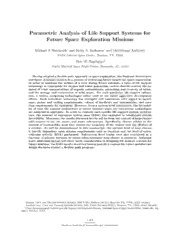
NASA Technical Reports Server (NTRS) 20100039597: Parametric Analysis of Life Support Systems for Future Space Exploration Missions PDF
Preview NASA Technical Reports Server (NTRS) 20100039597: Parametric Analysis of Life Support Systems for Future Space Exploration Missions
Parametric Analysis of Life Support Systems for Future Space Exploration Missions Michael J. Swickrath∗ and Molly S. Anderson† and (Additional Authors) NASA Johnson Space Center, Houston, TX, 77058 Bob M. Bagdigian‡ NASA Marshall Space Flight Center, Huntsville, AL, 35812 Having adopted a flexible path approach to space exploration, the National Aeronautics and Space Administration is in a process of evaluating future targets for space exploration. In order to maintain the welfare of a crew during future missions, a suite of life support technology is responsible for oxygen and water generation, carbon dioxide control, the re- moval of trace concentrations of organic contaminants, processing and recovery of water, and the storage and reclamation of solid waste. For each particular life support subsys- tem, a variety competing technologies either exist or are under aggressive development efforts. Each individual technology has strengths and weaknesses with regard to launch mass, power and cooling requirements, volume of hardware and consumables, and crew time requirements for operation. However, from a system level perspective, the favorabil- ity of each life support architecture is better assessed when the sub-system technologies are analyzed in aggregate. In order to evaluate each specific life support system architec- ture, the measure of equivalent system mass (ESM) was employed to benchmark system favorability. Moreover, theresultsdiscussedhereinwillbefromthecontextofloop-closure with respect to the air, water, and waste sub-systems. Specifically, closure relates to the amount of consumables mass that crosses the boundary of the vehicle over the lifetime of a mission. As will be demonstrated in this manuscript, the optimal level of loop closure is heavily dependent upon mission requirements such as duration and the level of extra- vehicular activity (EVA) performed. Sub-system level trades were also considered as a function of mission duration to assess when increased loop closure is practical. Although many additional factors will likely merit consideration in designing life support systems for futuremissions, theESMresultsdescribedhereinprovideacontextforfuturearchitecture design decisions toward a flexible path program. ∗Analyst,CrewandThermalSystemsDivision,2101NASAParkway/EC211,Houston,TX,77058,AIAAMember. †AnalysisLead,CrewandThermalSystemsDivision,2101NASAParkway/EC211,Houston,TX,77058,AIAAMember. ‡Chief,EnvironmentalControlandLifeSupportDevelopmentBranch,MarshallSpaceFlightCenter/ES62,Huntsville,AL, 35812,MemberAIAA. 1of1 AmericanInstituteofAeronauticsandAstronautics
